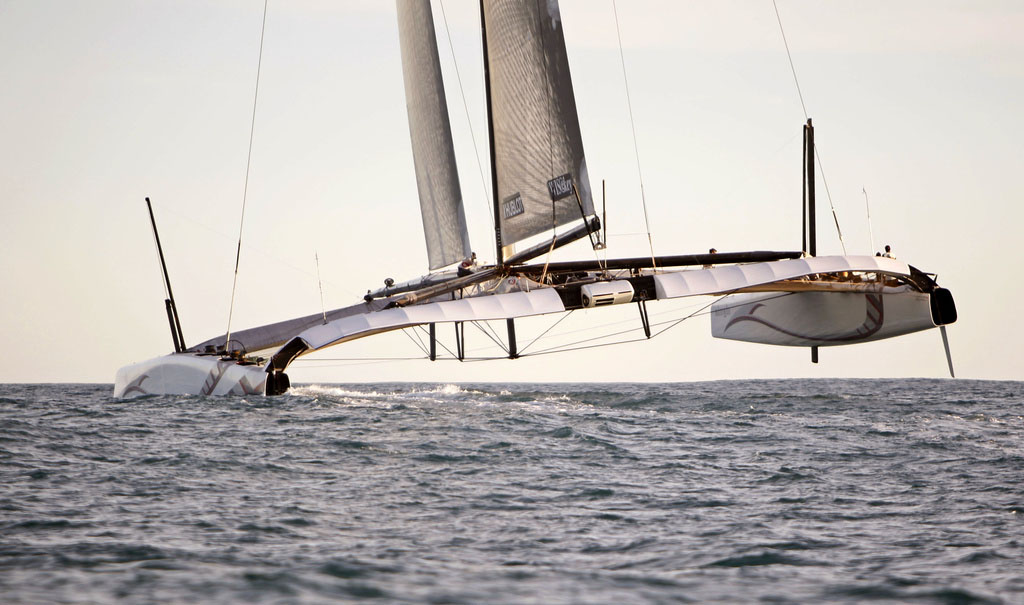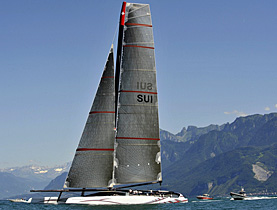The science behind the America’s Cup

No fewer than six labs at Lausanne's Federal Institute of Technology (EPFL) are involved in the development of Alinghi 5, the yacht that will defend the America’s Cup.
The university is official scientific advisor for Alinghi, holder of sailing’s most prestigious prize. Its chair of modelling and scientific computing, mathematics professor Alfio Quarteroni, oversees the team’s fluid dynamics research.
A specialist in computer simulations, Quarteroni’s job is to ensure that the Swiss yacht is designed to move through the water with as little resistance as possible.
The professor remembers when, in 2001, Alinghi owner, Ernesto Bertarelli turned to the EPFL and asked for it to become a scientific consultant. He was directed to a few different labs at the university, including Quarteroni’s.
“It was a fantastic moment but also made members of our staff a little bit afraid,” recalled Quarteroni. “This is understandable since scientists are not used to being involved in sporting competitions and having to meet the deadlines of such events.”
Until recently the best way to test a boat’s performance was to expose it to realistic flow situations in wind tunnels or tanks. The EPFL’s answer is mathematical and less expensive.
Turbulent waters
By using computational fluid and structural dynamics, a wide range of flow conditions around a computerised version of the yacht can be simulated, which even include a model taking into account unpredictable turbulence that can crop up under real racing conditions.
The findings have been used to allow the design team to identify the best model before being tested under real conditions.
Hundreds of millions of calculations were fed into a supercomputer to reach the optimum design. “More data was processed to simulate the sail’s wind resistance than is needed to make a three-day weather forecast for all of Italy,” Quarteroni said.
The scientist does not reveal many details about the Alinghi 5, saying only: “this vessel has little in common with the yachts used [in the America’s Cup] in 2003 and 2007.”
The 50-metre-high main mast is almost twice as tall as the Alinghi yacht that won the 2007 race.
Twice as fast
The gigantic main sail has a surface area 1,000 square metres. “The catamaran can go twice as fast as the last Alinghi yacht,” Quarteroni said.
The scientist is not only an exceptional mathematician but also has a talent for public speaking. Even though mathematics is not a subject of interest to a broad audience, he has inspired interest through his talks, which explain the interaction between “mathematics and Alinghi” or more generally between “mathematics and sport”.
More than 300 people came to hear him speak recently at a sport centre in Tenero, in southern Switzerland. Quarteroni was asked repeatedly if the athletes or the technology would decide the outcome of competitions like the America’s Cup, or if the huge investments in technology really made sense.
Quarteroni is convinced high-performance sports like yachting are an ideal field of experimentation for research.
Developers are not willing to take a risk and introduce new materials directly to the market, so they test them first in sport. This is why, for example, investments in research are made in Formula One racing.
“Sprinters no longer run with the same kind of shoes their predecessors wore 100 years ago,” the mathematician said.
Gerhard Lob in Tenero, swissinfo.ch (Adapted from the German by Dale Bechtel)
EPFL is the official scientific advisor to Alinghi for the 33rd America’s Cup, which begins on February 8.
Together with Alinghi’s design team and other partners, the institution will contribute to improve technology in many areas such as:
Composite materials – to optimize materials to make this Formula One of the sea both light and robust.
Fluid dynamics – to develop simulation tools to ensure that the yacht is designed to make the most of its water environment.
Sail visualisation – to measure the shape of sails in racing conditions so as to perfect them.
Optical measurements – fiber optics integrated in the yacht structure serve to measure key parameters in racing conditions.
Route optimization – the skipper’s instinct backed by computing.
Further research areas – kept confidential – are currently being investigated in various EPFL labs.

In compliance with the JTI standards
More: SWI swissinfo.ch certified by the Journalism Trust Initiative














You can find an overview of ongoing debates with our journalists here . Please join us!
If you want to start a conversation about a topic raised in this article or want to report factual errors, email us at english@swissinfo.ch.